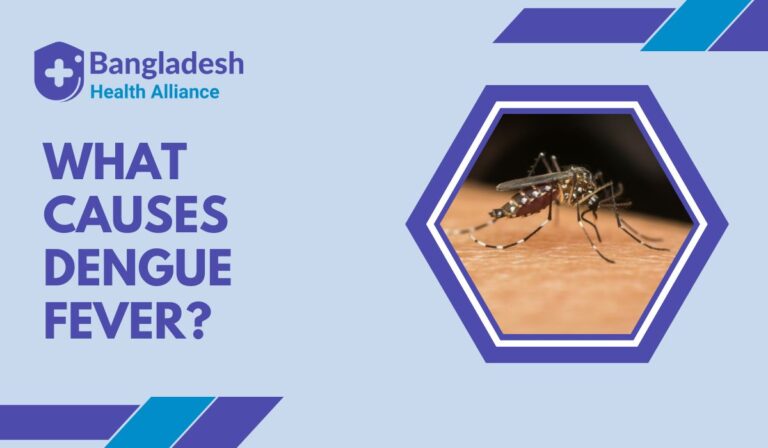Dengue fever, a formidable mosquito-borne viral illness, has become a significant public health concern in many tropical and subtropical regions, including Bangladesh. This article, presented by the Bangladesh Health Alliance, is dedicated to uncovering the causes of dengue fever, delving deep into the contributing factors that contribute to its emergence and transmission, supported by scientific references.
What Causes Dengue Fever? Unraveling the Underlying Causes
Dengue fever is caused by the dengue virus, which is primarily transmitted to humans through the bites of infected Aedes mosquitoes, particularly Aedes aegypti and, to a lesser extent, Aedes albopictus. These mosquitoes are commonly found in tropical and subtropical regions around the world.
When an infected mosquito bites a person, it can transmit the dengue virus into the person’s bloodstream. Once the virus is inside the body, it can replicate and spread, leading to the development of dengue fever. The symptoms of dengue fever can range from mild to severe and may include high fever, severe headache, joint and muscle pain, rash, and in some cases, a more severe form known as dengue hemorrhagic fever or dengue shock syndrome, which can be life-threatening.
Preventing dengue fever involves controlling mosquito populations and minimizing mosquito bites. This can be achieved through measures such as using insect repellents, wearing protective clothing, using mosquito nets, and eliminating mosquito breeding sites, such as standing water where mosquitoes lay their eggs. There is no specific antiviral treatment for dengue fever; supportive care and management of symptoms are important in helping patients recover.
The Viral Villain: Dengue Virus
At the heart of dengue fever lies the dengue virus, a member of the Flaviviridae family. This single-stranded RNA virus is classified into four distinct serotypes: DEN-1, DEN-2, DEN-3, and DEN-4. While all serotypes can cause dengue fever, they also have the potential to lead to more severe forms of the disease, including dengue hemorrhagic fever (DHF) and dengue shock syndrome (DSS).
Transmission Process
The transmission of the dengue virus is intricately woven into the life cycle of Aedes mosquitoes, particularly Aedes aegypti. Here’s how the virus spreads from host to host:
- Acquisition: An Aedes mosquito becomes infected with the dengue virus when it feeds on the blood of an infected human during the viremic phase of the illness. The virus then replicates and multiplies within the mosquito’s body.
- Incubation Period: During an incubation period of about 8 to 12 days, the virus reaches a critical concentration in the mosquito’s salivary glands, making it capable of transmitting the virus to humans.
- Bite and Transmission: When an infected mosquito bites a susceptible human, it injects the virus along with its saliva into the person’s bloodstream. The virus subsequently invades human cells, where it replicates and proliferates.
- Human Infection: Infected humans become carriers of the virus, serving as potential sources for new infections. If another mosquito bites an infected individual during the viremic phase, it can become infected and transmit the virus to subsequent hosts.
Contributing Factors
Several factors contribute to the emergence and spread of dengue fever:
- Mosquito Breeding Sites: Aedes mosquitoes thrive in areas with stagnant water. Poor waste management and inadequate drainage systems create breeding grounds for mosquitoes.
- Urbanization: Urban areas with crowded populations, limited green spaces, and suboptimal sanitation provide an ideal environment for mosquito proliferation.
- Climate and Weather: Warm and humid conditions accelerate mosquito development and the replication of the dengue virus, enhancing the risk of transmission.
- Globalization and Travel: Infected individuals traveling to new areas can introduce the virus to susceptible populations, triggering outbreaks.
Prevention and Control
Preventing dengue fever requires a comprehensive approach that addresses both mosquito control and public awareness:
- Source Reduction: Eliminate standing water and potential breeding sites by proper waste disposal and maintaining clean environments.
- Vector Control: Implement targeted measures, including larvicides and insecticides, to reduce mosquito populations.
- Personal Protection: Use mosquito nets, repellents, and wear protective clothing to minimize mosquito bites.
- Community Engagement: Raise awareness about dengue prevention and involve communities in mosquito control efforts.
- Healthcare and Surveillance: Establish effective surveillance systems and ensure access to medical care for timely diagnosis and treatment.
Learn From Video – What Causes Dengue Fever?
Dengue Fever – Causes, Symptoms, Treatment and Prevention By PACE Hospitals
https://youtu.be/ewvEXN4JZsw
In conclusion, dengue fever is caused by the dengue virus, primarily transmitted through the bites of infected Aedes mosquitoes. Understanding the factors that contribute to its spread is crucial for developing effective prevention and control strategies. By addressing mosquito breeding sites, promoting public awareness, and fostering community participation, we can collectively combat the causes of dengue fever and safeguard public health.
References:
- World Health Organization. (2021). Dengue and severe dengue. Link
- Centers for Disease Control and Prevention. (2021). Dengue. Link
- Ministry of Health and Family Welfare, Government of Bangladesh. (2021). National Guideline on Dengue Fever and Dengue Hemorrhagic Fever. Link
- Rajapakse, S., & Rodrigo, C. (2019). Dengue viral infections. Link


